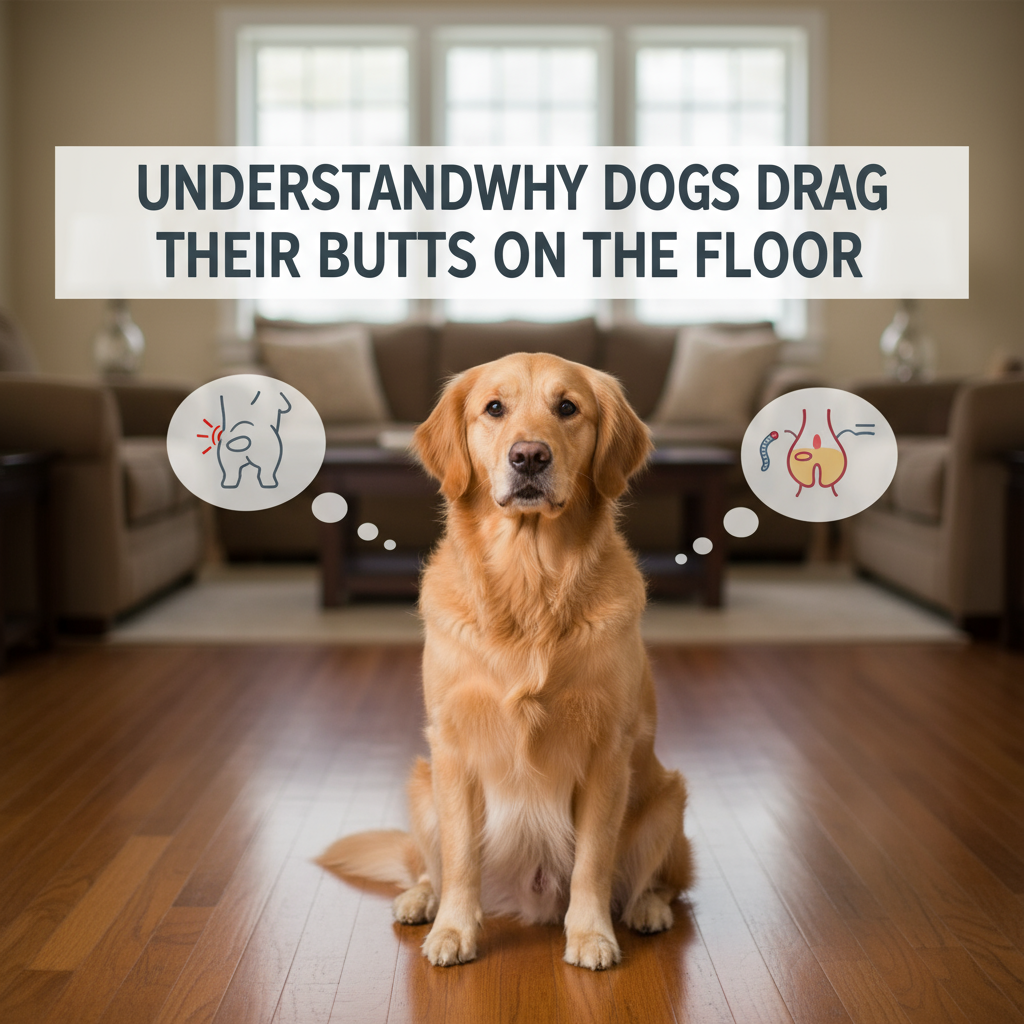Why Do Dogs Drag Their Butts on the Floor?
Estimated reading time: 4 minutes
- Understanding the causes: From anal gland issues to allergies.
- Signs to monitor: Watch for unusual symptoms in your pet.
- Veterinary consultation: Always seek professional help if concerned.
- Hygiene maintenance: Keep your dog clean to prevent irritation.
Table of Contents
- Understanding the Reasons for Butt Dragging
- Signs to Watch For
- What to Do If Your Dog Scoots
- Conclusion
- FAQ
Understanding the Reasons for Butt Dragging
Scooting is a common behavior exhibited by dogs, often signaling discomfort or irritation in the anal area. Let’s delve deeper into some of the most prevalent causes:
1. Anal Gland Issues
One of the most frequent culprits behind scooting is anal gland problems. Dogs have two small glands located on either side of the anus that produce a secretion used for marking their territory. When these glands become clogged, impacted, or infected, they can lead to significant discomfort. As a result, dogs may drag their bottoms on the floor to relieve the pressure. Regular veterinary checkups can help catch these issues before they escalate. Source, Source, Source.
2. Parasites (Worm Infestations)
Parasites like tapeworms can also cause itching and irritation around a dog’s anus, contributing to scooting behavior. It’s crucial for pet owners to maintain a regular deworming schedule; this simple management practice can significantly help in alleviating discomfort. Source, Source.
3. Skin Irritation or Allergies
Many dogs suffer from allergies, whether they’re environmental or food-related, leading to skin irritation around the anal area. This chronic irritation often results in excessive itching, prompting dogs to scoot. Allergies may also stem from flea infestations or grooming issues, so maintaining your dog’s hygiene is vital. Source, Source, Source.
4. Impacted Feces
Another common reason dogs scoot is impacted feces. Dry, hard stools can become lodged in the rectum, leading to discomfort and prompting the dog to drag its behind. Regular monitoring of your dog’s bowel movements is crucial for early intervention. Source.
5. Constipation
A diet lacking adequate fiber can lead to constipation, making it difficult for dogs to pass their stools, which may result in discomfort and subsequent scooting. Ensuring a well-balanced diet rich in fiber can mitigate constipation-related issues. Source.
6. Anal Fissures and Hemorrhoids
Just like humans, dogs can experience anal fissures and hemorrhoids, which are painful and could result in itching and discomfort in the anal area. These conditions are serious and require immediate veterinary attention. Source.
7. Skin Infections
Bacterial or yeast infections can cause irritation and soreness in the anal area. Keeping this region clean is critical for preventing such infections and their associated scooting behaviors. Source.
Signs to Watch For
As dog owners, being vigilant about our pets’ behavior is crucial. Here are some signs that may indicate a more serious issue if your dog scoots:
- Discolored Trails or Smelly Odors: If you notice a discolored trail or a strong odor accompanying your dog’s scooting, it may be a sign of anal gland issues. Source.
- Bleeding, Bruising, or Swelling: Any signs of bleeding, bruising, or swelling necessitate a trip to the veterinarian, as these indicators may point toward severe infections. Source.
- Excessive Licking or Biting: If your dog is persistently licking or biting the anal area, it could indicate pain or discomfort, requiring immediate veterinary consultation. Source.
What to Do If Your Dog Scoots
If you’ve identified that your dog is scooting, here are some steps that you should take:
1. Consult a Veterinarian
The first step is always to consult with your veterinarian if your dog frequently scoots. They can help identify any underlying health issues and recommend appropriate treatments. Source, Source.
2. Expressing Anal Glands
If your vet determines that anal glands are the issue, they might need to manually express them to relieve pressure. Regular expressions can sometimes prevent future issues that lead to scooting. Source.
3. Treat Allergies and Parasites
For allergies, implementing a proper medication plan or dietary changes can be beneficial. If parasites are the issue, your vet can recommend deworming treatments to keep your pet comfortable. Source, Source.
4. Maintain Hygiene
Keeping the area around your dog’s rear clean is paramount. Regular grooming and bathing help prevent unnecessary irritation. Source.
By understanding the causes of scooting and taking prompt action, pet owners can significantly alleviate their dog’s discomfort and ensure they lead happy and healthy lives.
Conclusion
Scooting is a common yet sometimes distressing issue for pet owners. By understanding the various reasons behind this behavior, such as anal gland issues, parasites, allergies, and others, you can take appropriate measures to help your beloved pet. Your dog’s comfort and health should always come first, which is why a prompt visit to the veterinarian is highly recommended if you notice frequent scooting behavior.
At Your Company Name, we specialize in providing expert pet consulting services to ensure that pets receive the care they deserve. From understanding pet behaviors to automating business processes through n8n workflows, we are here to help streamline your experience as a pet owner and professional.
If you have questions, need assistance, or are interested in our services, please don’t hesitate to contact us today. Let’s keep your furry companions healthy and happy together!
FAQ
Why does my dog scoot?
Dogs may scoot due to various reasons, including discomfort from anal gland issues, irritation from parasites, allergies, or even constipation.
When should I take my dog to the vet for scooting?
You should consult a veterinarian if the scooting is frequent or accompanied by other concerning symptoms such as bleeding or unusual odors.
How can I prevent my dog from scooting?
Maintain your dog’s hygiene, feed a balanced diet, and schedule regular veterinary checkups to catch any issues early.
